Wednesday, June 30, 2004
Friday, June 25, 2004
AOL 1st ANNIVERSARY CELEBRATION!!!
succulent wisdom - juicyness from j-land
B2B INTERNATIONAL - Powered by FlashBuilder.net - Free Flash Website sitebuilder + Free Hosting
AOL Journals' First Year Hall of Fame
I hope that everyone will check out these five journals, wonderful portals into the AOL 1st Anniversary Celebration!
JAMES AND THE ANIMALS PARTXXXVII 37 is posted
JAMES AND THE ANIMALS PART XXXVIII 38 is posted
Wednesday, June 23, 2004
B O O K S
JAMES AND THE ANIMALS PART XXXV 35 is posted.
JAMES AND THE ANIMALS PART XXXVI 36 is posted.
Sunday, June 20, 2004
F A T H E R ` S D A Y
Growing up, I was the first born son in the family. My Mom was the dominating force in the family, always stressing education, getting ahead, becoming something more. We were very poor, though seldom without food, and my Dad was more of a shadowy figure to me. [ My sister, brother & I eventually earned 7 college degrees between us! ]
As first-born son, and favored by my Mom because of how well I did in school, a not always unspoken rivalry was set up between my Dad and I. We did little together; he seldom attended my sports games, except all-star games or basketball playoff games. Of course, I seldom asked him!
He and my younger brother were very close. My Dad not only attended his games, he became a coach in all the leagues my brother played in, moving up with him as my brother grew older.
A funny thing happened, however, as I grew older and had my own son. Family would say to me, over and over, " You`re just like your Father! " And they were right! My personality is much more like his than Mom`s, my expressions and oddities are his.
As I grew into my thirties, my Dad and I became quite close. My Mom used to kid him because, most nights, he would say to her, " Well,I think I`ll give Vinnie a call." We had a chance to talk about the rivalry when I was growing up, and we spoke about fears and things, in addition to sports.
I think we were both so lucky to have met each other, before he died.
HAPPY FATHER`S DAY, DAD.
Happy Father`s Day to all the Dads in J-Land, present or in spirit.
Vinnie
http://journals.aol.com/deabvt/JAMESANDTHEANIMALS/entries/834 James xxxiv, 34, is posted.
Saturday, June 19, 2004
" Bouquet of Flowers in a Vase " 1862 Gustave Courbet
![]()
Courbet, Gustave (1819-77). The painter Courbet started and dominated the French movement toward realism. Art critics and the public were accustomed to pretty pictures that made life look better than it was. Courbet, against much opposition, truthfully portrayed ordinary places and people.
Gustave Courbet was born on June 10, 1819, to a prosperous farming family in Ornans, France. He went to Paris in 1841, supposedly to study law, but he soon decided to study painting and learned by copying the pictures of master artists. In 1844 his self-portrait, Courbet with a Black Dog, was accepted by the Salon, an annual public exhibition of art sponsored by the influential Royal Academy.
In 1848 a political revolution in France foreshadowed a revolution in art, as people in the arts became more open to new ideas. Courbet's early work was exhibited successfully in 1849. That same year he visited his family in the countryside and produced one of his greatest paintings, The Stone-Breakers, followed by Burial at Ornans in 1850. Both were quite unlike the romantic pictures of the day because they showed peasants in realistic settings instead of the rich in glamorized situations. In 1855 he completed a huge canvas, The Artist's Studio, and, when it was refused for an important exhibition, Courbet boldly displayed his work himself near the exhibition hall.
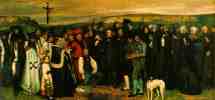 A Burial at Ornans
A Burial at Ornans
1849-50 (130 kB); Oil on canvas, 314 x 663 cm (10" 3 1/2" x 21' 9"); Musee d'Orsay, Paris
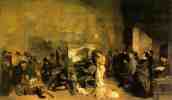 The Painter's Studio; A Real Allegory
The Painter's Studio; A Real Allegory
1855 (170 kB); Oil on canvas, 361 x 598 cm (11' 10 1/4" x 19' 7 1/2"); Musee d'Orsay, Paris
Courbet visited Germany in 1856, where he was welcomed by the artistic community. By 1859 he was the undisputed leader of the new generation of the French realist movement. He painted all varieties of subjects, including admirable portraits and sensuous female nudes but, most of all, scenes of nature. His series of seascapes with changing storm clouds wafting overhead begun in 1865 had a great influence on impressionist painters.
Politically a socialist, Courbet took part in some revolutionary activities for which he was imprisoned for six months in 1871. He was also fined more than he could pay, so he fled to Switzerland, where he died in the town of La Tour-de-Peilz on Dec. 31, 1877.
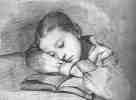 Portrait of Juliette Courbet as a Sleeping Child
Portrait of Juliette Courbet as a Sleeping Child
1841 (110 kB); Graphite on paper; Musee d'Orsay
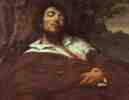 The Wounded Man
The Wounded Man
1844-54 (60 kB); Musee d'Orsay
 La Mere Gregoire
La Mere Gregoire
1855-59 (40 kB); Art Institute of Chicago
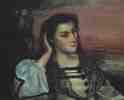 Portrait of Gabrielle Borreau (The Dreamer)
Portrait of Gabrielle Borreau (The Dreamer)
1862 (60 kB); Oil on paper mounted on canvas; Art Institute of Chicago
Synopsis courtesy- Web Museum, Paris
Painting courtesy-J. Paul Getty Museum, Los Angeles
Tuesday, June 15, 2004
DISMAY------FAITH
Dismay is that which darkens,
Makes one downhearted
and wraps our heart in fear.
Faith is that which lightens,
Breathes sunlight to the dark
energizes our hopes and dreams.
http://journals.aol.com/deabvt/JAMESANDTHEANIMALS/entries/793
http://journals.aol.com/deabvt/JAMESANDTHEANIMALS/entries/796
Friday, June 11, 2004
REPOST ENTRY OF JANUARY 23, 2004
Every winter,in January or february,on a weekday,my son and i would play hooky and go to the philadelphia zoo. We would pick a day when few visitors would be expected and arrive early . On one of these days,when my son was about 8, we entered a nearly empty zoo. It was very cold and threatening to snow and all of the animals were indoors. Zoo workers were huddled inside drinking coffee,warming,and as we walked up the main road [past the Reptile House] my son started tugging my hand " Dad, the Tigers! Let`s go to the Tiger House!" Something we shared ,the tigers were our favorite animals.We circled to the right and entered the Tiger House.The leopards and pumas always had access to the outdoors and were always pacing in and out. Each of these smaller cats was caged singly and i always wondered if all of their pacing was due to the fact that their only contact with other animals was when they and their neighbors had both paced to their outside cages. As I was brooding over this,my son Sean kept urging me cage to cage, for the tigers were at the end of the building. Finally we arrived at the last lonely but hot wired leopard,turned the corner ,and there they were! In the first cage was The Boss,an elderly but still regal male who was older than Sean and was Sean`s favorite."Good Morning,Samson",he said,and strained to get closer.Excitedly,he ran down past the cages,trying to take them all in, while I pondered Samson and how it is to get old,and Death.[sounds dumb and obsessive ; I was a Psych Grad student and was dumb and obsessive!]Pondering was interrupted by Sean`s yells..."Dad, they`re here! Dad, they`re here!"It was the three baby tiger cubs on their very first week of display. The cubs stopped playing and stared at Sean,and Sean did an amazing thing! He moved out of their view to the left, and they gathered to that side of the cage.As he moved back in front of them, he said "peek-a-boo" and the three cubs jumped and started prancing. For the next 15 minutes, I just stood there laughing and eventually crying at the antics of the four cubs [3 tiger and 1 human].A Wonderful Time!
Saw Gregg`s Great repost... Here`s one of mine!!
Vince
Gregg!! THANKS FOR THE TERRIFIC GRAPHIC!
Thursday, June 10, 2004
Ray Charles Died Today June 10, 2004
Thu 10 June, 2004 21:55

RELATED ARTICLES Music icon Ray Charles dies
By Steve James
"The only genius in the business," Frank Sinatra once said of Charles.
Charles' response: "(Jazz pianist) Art Tatum, he was a genius, and Einstein. Not me."
Whether singing the blues or playing jazz, crooning a ballad or yodeling country and western, Charles combined the raw emotions of black gospel with the sophistication of classical training.
Blind since the age of six, Charles battled childhood poverty and later heroin addiction to become one of the world's most enduring performers.
Drawing on influences as diverse as Chopin and Sibelius, Tatum, Artie Shaw and Nat "King" Cole, Ray Charles helped revolutionize popular music in the 1950s, leading the way for such performers as Elvis Presley, Buddy Holly, Chuck Berry and Sam Cooke and what was to become rock 'n' roll.
His "I Got A Woman", is widely considered to be the key that opened the door for a crossover of the black musical heritage into the white American musical mainstream.
By taking the traditional gospel "My Jesus Is All The World To Me", and adding secular lyrics, Charles came up with a song that, though not a chart hit, was popular on both sides of the racial divide in 1954.
"For blacks it served as unabashed celebration of negritude without religion; to whites it opened doors that had always been shut," said Peter Guralnick, a music writer and historian.
GOT FLAK
"I got a lot of flak because some people felt it was like an abomination of the church. But then people beganto realize ...'The man is just singing what he feels. He's got to sing it the way he feel it.' That was when I gave up trying to sound like anyone else," Charles once told an interviewer.
He was calling his style "soul music" then -- a decade before it was recognized as a distinct genre.
Born Ray Charles Robinson on September 23, 1930 in Albany, Georgia, he was raised in Greenville, Florida, by his mother and his father's first wife.
His mother took in laundry to make ends meet and at the age of 5 he watched powerless as his older brother drowned in a tub. The next year, he lost his sight to glaucoma.
When he was seven, his mother enrolled him in St. Augustine's School for the Deaf and Blind, where he learned to read and write music in Braille, score for big bands, and play the piano, alto sax, organ, trumpet and clarinet.
Devastated at age 15 by the death of his mother, he quit school, heading for Jacksonville and a career in music.
Two years later after playing with a jazz band and a hillbilly group called the Florida Playboys, Ray Charles took his savings of $600 and went to Seattle.
There he changed his name to Ray Charles -- to avoid confusion with the boxer Sugar Ray Robinson -- made his first record ("Confession Blues" - 1948) and got hooked on heroin.
"I did it to myself. It wasn't society ... it wasn't a pusher, it wasn't being blind or black or being poor. It was all my doing," he wrote in his autobiography "Brother Ray."
He had several rhythm and blues hits over the next four years and learned the business.
"He was like 40 years old," said a young Quincy Jones, who met Charles in Seattle. "He knew everything. He knew about ladies and music and life, because he was so independent."
BIG BREAK
His big break came in 1952 when Atlantic Records signed him to a contract and he recorded "I Got A Woman." The song wasn't an immediate hit, but Charles had his fair share of chart success in the years that followed.
Another gospel song "This Little Light Of Mine," became "This Little Girl Of Mine," and Charles introduced a female vocal group, the Raelettes, who backed him up almost like a choir.
Between 1954 and 1959, Charles had a string of hits -- "Yes, Indeed", "Hallelujah, I Love Her So", "Drown In My Own Tears", and "Night Time Is The Right Time", before he recorded his first million-seller "What'd I Say?" -- which was banned on radio stations across America but still became a hit.
Changing labels from Atlantic to ABC at age 29 in 1959, Charles then recorded more sentimental songs such as "Ruby" and "Georgia On My Mind," but still had hard-edged R&B hits like "Hit the Road, Jack" and "Let's Go Get Stoned".
In 1963 his "Modern Sounds in Country and Western Music" album -- on which he was backed by an 18-piece orchestra -- yielded four Top-10 hit singles plus "I Can't Stop Loving You", which sold 3 million copies.
His 15 years of drug addiction become public knowledge with his 1964 arrest in Boston for heroin possession. He stopped touring for all of 1965 to kick the habit.
In "Brother Ray", he told of the court case in which he had to prove to the judge he was off drugs.
"I walked out just as I had walked in -- my own man. The only difference was that I didn't need a fix every morning."
In 1973 he split with ABC Records and formed his own label, Crossover, producing and engineering his own records.
In 1986, Ray Charles was honored by President Ronald Reagan as one of the recipients of the Kennedy Center Awards, given for outstanding contributions to the performing arts in America.
Yet, he considered one of his greatest honors having the Georgia legislature adopt "Georgia On My Mind" as the official state song.
Charles had at least nine children with five different women. His 20-year marriage to Della, one of his original Raelettes, ended in divorce in 1977.
Article courtesy of Reuters UK, June 10, 2004
ray_charles What I Say
El Greco "BAPTISM OF CHRIST" 1608-14 Hospital de San Juan de Alfuerra, Toledo
![]()
Greco, El (1541-1614). Cretan-born painter, sculptor, and architect who settled in Spain and is regarded as the first great genius of the Spanish School. He was known as El Greco (the Greek), but his real name was Domenikos Theotocopoulos; and it was thus that he signed his paintings throughout his life, always in Greek characters, and sometimes followed by Kres (Cretan).
Little is known of his youth, and only a few works survive by him in the Byzantine tradition of icon painting, notably the recently discovered Dormition of the Virgin (Church of the Koimesis tis Theotokou, Syros). In 1566 he is referred to in a Cretan document as a master painter; soon afterwards he went to Venice (Crete was then a Venetian possession), then in 1570 moved to Rome. The miniaturist Giulio Clovio, whom he met there, described him as a pupil of Titian, but of all the Venetian painters Tintoretto influenced him most, and Michelangelo's impact on his development was also important.
 View of Toledo
View of Toledo
c. 1597 (180 Kb); Oil on canvas, 121.3 x 108.6 cm (47 3/4 x 42 3/4 in); The Metropolitan Museum of Art, New York
Among the surviving works of his Italian period are two paintings of the Purification of the Temple (Minneapolis Institute of Arts, and NG, Washington), a much-repeated theme, and the portrait of Giulio Clovio (Museo di Capodimonte, Naples). By 1577 he was at Toledo, where he remained until his death, and it was there that he matured his characteristic style in which figures elongated into flame-like forms and usually painted in cold, eerie, bluish colors express intense religious feeling. The commission that took him to Toledo -- the high altarpiece of the church of S. Domingo el Antiguo -- was gained through Diego de Castilla, Dean of Canons at Toledo Cathedral, whom El Greco had met in Rome. The central part of the altarpiece, a 4-m. high canvas of The Assumption of the Virgin (Art Institute of Chicago, 1577), was easily his biggest work to date, but he carried off the dynamic composition triumphantly. A succession of great altarpieces followed throughout his career, the two most famous being El Espolio (Christ Stripped of His Garments) (Toledo Cathedral, 1577-79) and The Burial of Count Orgaz (S. Tomé, Toledo, 1586-88). These two mighty works convey the awesomeness of great spiritual events with a sense of mystic rapture, and in his late work El Greco went even further in freeing his figures from earth-bound restrictions; The Adoration of the Shepherds (Prado, Madrid, 1612-1614), painted for his own tomb, is a prime example.
 El Espolio (The spoliation, Christ Stripped of His Garments)
El Espolio (The spoliation, Christ Stripped of His Garments)
1577-79 (210 Kb); Oil on canvas, 285 x 173 cm; Sacristy of the Cathedral of Toledo
 The Adoration of the Shepherds
The Adoration of the Shepherds
1612-14 (230 Kb); Oil on canvas, 319 x 180 cm (125 5/8 x 70 7/8"); Museo del Prado, Madrid
El Greco excelled also as a portraitist, mainly of ecclesiastics (Felix Paravicino, Boston Museum, 1609) or gentlemen, although one of his most beautiful works is a portrait of a lady (Pollock House, Glasgow, c. 1577-80), traditionally identified as a likeness of Jeronima de las Cuevas, his common-law wife. He also painted two views of Toledo (Met. Museum, New York, and Museo del Greco, Toledo), both late works, and a mythological painting, Laocoön (National Gallery, Washington, c. 1610), that is unique in his oeuvre. The unusual choice of subjects is perhaps explained by the local tradition that Toledo had been founded by descendants of the Trojans. El Greco also designed complete altar compositions, working as architect and sculptor as well as painter, for instance at the Hospital de la Caridad, Illescas (1603). Pacheco, who visited El Greco in 1611, refers to him as a writer on painting, sculpture, and architecture. He had a proud temperament, conceiving of himself as an artist-philosopher rather that a craftsman, and had a lavish life-style, although he had little success in securing the royal patronage he desired and seems to have had some financial difficulties near the end of his life. His workshop turned out a great many replicas of his paintings, but his work was so personal that his influence was slight, his only followers of note being his son Jorge Manuel Theotocopouli and Luis Tristán. Interest in his art revived at the end of the 19th century, and with the development of Expressionism in the 20th century he came into his own. The strangeness of his art has inspired various theories, for example that he was mad or suffered from astigmatism, but his rapturous paintings make complete sense as an expression of the religious fervour of his adopted country.
[Vince, added.] In many museums, including the Barnes Museum near Philly, where I first saw his paintings, his work is displayed above eye level to compensate for the "Strangeness", or astigmatism. Interesting!
JAMES AND THE ANIMALS PART XXX 30 is posted!
V
Friday, June 4, 2004
Scalzi`s Weekend assignment
In response to Scalzi`s weekend assignment, I`m presenting the synopsis to the greatest book that I`ve ever read, and one that i very much identified with at the time. Bellow is, for me, the greatest living writer of English fiction.
Winner of the National Book Award when it was first published in 1964, Herzog traces five days in the life of a failed academic whose wife has recently left him for his best friend. Through the device of letter writing, Herzog movingly portrays both the internal life of its eponymous hero and the complexity of modern consciousness.
Like the protagonists of most of Bellow's novels—Dangling Man, The Victim, Seize the Day, Henderson the Rain King, etc.—Herzog is a man seeking balance, trying to regain a foothold on his life. Thrown out of his ex-wife's house, he retreats to his abandoned home in Ludeyville, a remote village in the Berkshire mountains to which Herzog had previously moved his wife and friends. Here amid the dust and vermin of the disused house, Herzog begins scribbling letters to family, friends, lovers, colleagues, enemies, dead philosophers, ex- Presidents, to anyone with whom he feels compelled to set the record straight. The letters, we learn, are never sent. They are a means to cure himself of the immense psychic strain of his failed second marriage, a method by which he can recognize truths that will free him to love others and to learn to abide with the knowledge of death. In order to do so he must confront the fact that he has been a bad husband, a loving but poor father, an ungrateful child, a distant brother, an egoist to friends, and an apathetic citizen.
As Herzog obsessively reviews the evidence of Madeleine's and Gersbach's affair, we piece together the circumstances of Herzog's recent past: how Madeleine ached to leave their Emersonian life in the Berkshires, how she grew fond of the flamboyant and masculine Valentine Gersbach, how, after their marriage dissolved in Chicago, Herzog took his melancholy to Europe, and how he returned to interrogate each and every one of their friends about Madeleine's adultery. These recollections impugn not only Madeleine andGersbach, but, more significantly, they impugn Herzog for overvaluing his own suffering. At one lucid point, he borrows a line from Shelley to express the relative meaninglessness of his suffering: "I fall upon the thorns of life, I bleed. And then? I fall upon the thorns of life, I bleed. And what next?" His sense of injury may be great but what of the pain felt by people like his childhood friend Nachman whose wife has lapsed into insanity? What of the pain of Madeleine's mother Tennie who is left by her playboy ex-husband and her inattentive daughter to age alone? Herzog also asks what the suffering of a cuckolded man is worth in relation to the collective sufferings of societies living in the shadow of Hiroshima and the Holocaust? As a former scholar of Romanticism, Herzog is compelled to weigh serious questions of culture and civilization. Thinking of the world wars, perhaps too of America's involvement in Vietnam and its battles over racism, Herzog wryly revises De Tocqueville's prediction that modern democracies would produce less crime but more private vice to "less private crime, more collective crime." The betrayal he has experienced at the hands of friends and lovers is mirrored by the betrayal he feels at the hands of modern American society where "people are dying...for lack of something real to carry home when day is done." While the garbled, fragmentary letters often display the clashing of personal and public crises; for Herzog the project to restore oneself and the project to restore civilization are really one. It is a Romantic idea that finds eloquent expression in Blake whose work is repeatedly invoked by Herzog.
Crucial to the restoration of American culture, Herzog believes, is a condemnation of the "wasteland outlook." Referring to an intellectual tradition based on the bleak diagnoses of modern civilization by Nietzsche, T. S. Eliot, Spengler, Heidegger and other existentialist philosophers, Herzog laments the wasteland outlook as "the full crisis of dissolution...the filthy moment...when moral feeling dies, conscience disintegrates, and respect for liberty, law, public decency, all the rest, collapses in cowardice, decadence, blood." Real transcendence, according to the wasteland outlook, is only possible in the immoral, "gratuitous" act. In opposition to this philosophy, Herzog offers the wisdom of Blake: "Man liveth not by self alone but in his brother's face...Each shall behold the Eternal Father and love and joy abound." Bellow dramatizes, with comedic effect, these ideas in the "murder" scene. Pistol wielding Herzog realizes, as he peers through Madeleine's bathroom window and sees his wife's lover bathing his own daughter, that the taking or the saving of life has meaning. He resists the temptations of immoralism, and through this act of moral will Herzog manages to regain his balance. That Herzog transcends his personal hurt while being charged at the police station is both ironic and deeply affecting. Now with a "tranquil fullness of heart" he can compose letters of a different character. He reaches out in love to join the human race, writing to his dead mother, to congratulate a colleague on a recent book, to Nietzsche to resolve his mixture of admiration and distrust, to God to affirm his will to live, and to himself in which he rises to a state of rapture: "Something produces intensity, a holy feeling, as oranges produce orange, as grass green." In the end, with "not a single word" left to say, Herzog is restored to himself.
Herzog is primarily a novel of redemption. For all of its innovative techniques and brilliant comedy, it tells one of the oldest of stories. Like the Divine Comedy or the dark night of the soul of St. John of the Cross, it progresses from darkness to light, from ignorance to enlightenment. Today it is still considered one of the greatest literary expressions of postwar America.
Synopsis courtesy of Penguin Reader`s Guide
Thursday, June 3, 2004
A PLEASANT EVENING AT HOME
Alone, circular thoughts demand attention.
The world, filled with sadness and despair
Drives us to earlier worlds
and engages our attention
to the futility of life.
Feeling worthless and humbled,
the razor is inviting.
c 2004 Deabler, V.T.
James 28 is posted.
